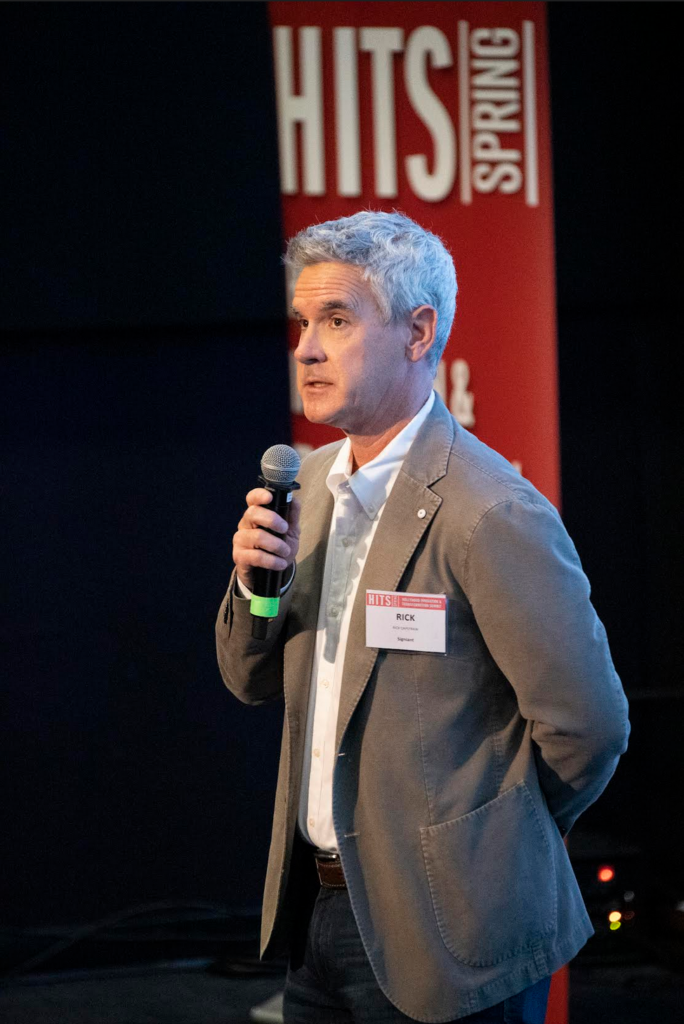
HITS 2023: Signiant Shows How Companies Can Bring Platform Power to Automation Workflows
Although the advantages of automation are undeniable, it is still too expensive and inefficient for each media organization to undertake a custom design/build/operate workflow initiative, according to Rick Capstraw, chief growth officer at Signiant.
With a multi-tenant Software-as-a-Service (SaaS) platform that is already operating at scale, Signiant is uniquely positioned to deliver ecosystem leverage through reusable, productized workflow building blocks, he said May 23 at the Hollywood Innovation and Transformation Summit (HITS) at The Culver Theater, during the session “Bringing Platform Power to Automation Workflows.”
These building blocks are easily connectable with modern application programming interfaces (APIs). These next-generation media process automation modules will provide optionality, scalability, short time to value (TTV) and high resiliency/availability, according to Signiant.
Capstraw kicked off the session by telling attendees: “I am going to be talking a little bit today about automation, workflows and the power of a platform in actually delivering that automation. I will not at all be talking about AI. I think this is the only sanctuary of any of these theaters at the moment. So if you are happy to have a respite from the nonstop talk about AI, this is it. If you’re looking to talk about AI and workflows, you’re in the wrong room.”
 Signiant and its content exchange platform and products “have been in the market for many, many years,” he said, adding: “In the sense of that product suite, we have done a, a number of workflow automation steps”
Signiant and its content exchange platform and products “have been in the market for many, many years,” he said, adding: “In the sense of that product suite, we have done a, a number of workflow automation steps”
But he said: “Really today I’m talking about where we are headed, built off an acquisition that we made about 18 months ago of a company called Levels Beyond with a product called Reach Engine.”
Signiant is approaching content automation workflows as a “multi-tenant platform, and the power that we believe that that brings to a unique approach to automation workflows,” he explained.
Signiant also offers fast, secure content exchange, he noted.
Over the past few years, the company has “transformed the way our business operates internally from what used to be a on-premise, software-based file exchange to a multi-function SaaS platform at this point,” he pointed out.
“In the case of traditional sign and content exchange, if your post-production studio is on the same platform for content exchange as your sets and your archive, then that adds a significant amount of value,” he noted. “If you’re also connected with your distribution partners, [there is] even more value” but one thing that a platform “really needs [is] to be deployed at scale in order to add significant value,” he added.
He went on to say that, “in an ecosystem connected to each other, scale is critically important, so over the last 10 years or so, as Signiant has built out our content exchange platform into truly a multi-tenant SaaS platform, we’ve started to think a little bit differently about how we can and should be structuring.”
He then turned his focus to automated workflows within the content ecosystem. Over the past 10 years, “we’ve seen some pretty massive disruption of the way that content is distributed to consumers,” he said, noting it is through multiple platforms, a lot of it via streaming. Now, “we’ve got one pipeline to hundreds and hundreds of pipelines for any given piece of content or studio,” he noted.
And that is the world that we now live in, he said, noting: “Reach Engine fits right in that workflow [and] we deliver many pieces of content into many workflows and packages and deliver it out to many different distribution pieces. And generally, within that structure, you’ll see three different things: They may be all one thing. They may be individual pieces in parts of technology but” media asset management workflow orchestration, and then role specific user experience.”
That, he explained is: “How we make this work and it’s generally been pretty successful.” In most cases, he said, it’s “on-prem or it’s possibly single tenant in the cloud and it works but you end up with kind of what this looks like: You have a single point of ingest. Could be cloud [or it] could be on-prem. You have a single tenant platform, piece of software, which is doing exactly what you want it to do because you’ve been able to tweak [and] develop, over time, the exact process and system that you need to deliver to Hulu. And then you have also built and delivered another separate process that is almost exactly the same thing but needs to go to Fox. So there’s a slightly different transcode and what you end up with there is a big spaghetti mess of custom workflows in the middle.”
But he said, “luckily, of course, from a technology perspective, we’ve all done a pretty good job of making those workflows modern, loosely coupled, fungible across systems and processes.” On the other hand, while they still work, he pointed out: “They’re really not scalable [and aren’t] resilient. If you need to change any sort of piece or part of the process, you’re changing an entire workflow. If you want to switch anything out, God forbid, switch out your cloud provider, switch out your storage, switch out your QC vendor, switch out your encoder.”
That, he said, is a “very cumbersome and difficult process, no matter how you’ve architected it, because you probably have about hundreds, if not thousands of individual workflows and processes that are all tied up into that piece and component.”
Signiant, as a result, “started to think a little bit about how we could take this already deployed, well utilized but highly complicated service and add in or revamp it into a more productized way of delivering a media factory pipeline,” he explained. And the company also “started thinking about why [it was] reinventing the wheel every single time we need a new workflow,” he noted.
And that, he said, “fits really well into the transformation of the way that we are packaging and delivering content through a high mix media supply chain: That is to focus on simplifying the tasks that are being done and then productizing them so that they can be reused and scalable across not just a single organization and a single media pipeline, but across the entire industry.”
Concluding, he said: “That’s our view of what we are trying to deliver at Signiant across platform use of process automation, and you’ll be hearing a lot more from us, hopefully, over the next six months as we start to put more code and product rollout to a lot of this stuff that has been separate for the last several years.”
The Hollywood Innovation and Transformation Summit event was produced by MESA in association with the Hollywood IT Society (HITS) and presented by Amazon Studios Technology, with sponsorship by Fortinet, Genpact, Prime Focus Technologies, Signiant, Softtek, Convergent, Gracenote, Altman Solon, AppTek, Ascendion, Coresite, EPAM, MicroStrategy, Veritone, CDSA, EIDR and PDG Consulting.
